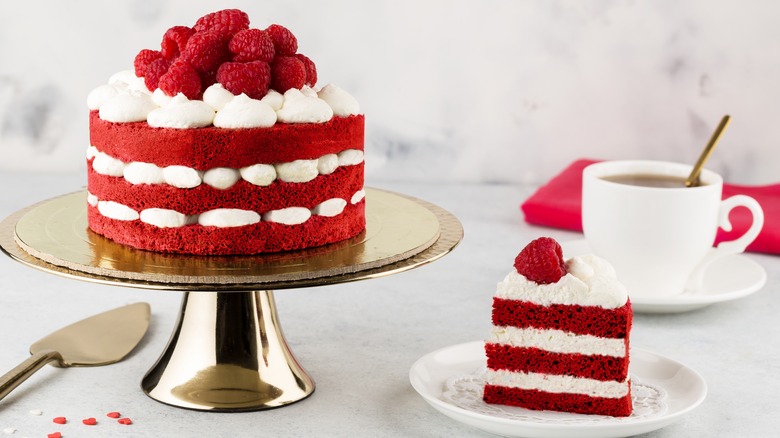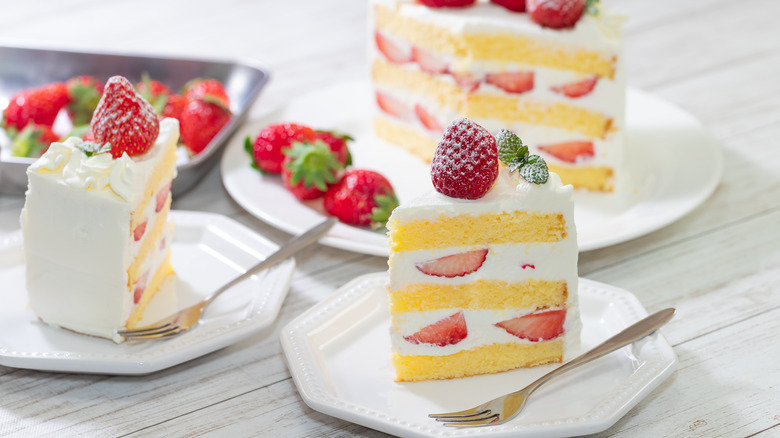The Cutting Tip To Keep In Mind For Perfect Slices Of Cake
There's a reason why cakes are served at special occasions: Baking a cake from start to finish is a bit of an undertaking. Some treats come together quickly, but a homemade cake made from scratch takes several steps, and that's just the baking part. Once you have the cake mixed, baked, and cooled, it needs to be frosted and decorated.
With all that work involved, it's no wonder bakeries always seem to be busy. If you've spent some quality time baking the perfect birthday, anniversary, or going-away party cake, or if you spent your hard-earned money on something special from the bakery, don't foul it up in the last stretch when it's time to cut. When you're cutting a cake, be sure to clean off the knife between cuts.
Cakes are delicate confections, and it not only takes work but also a little science to get your layers to rise and to get the crumb to set. If you don't clean off your knife between cuts, you can crush all that delicate crumb, and of course, mess up the beautiful frosting too. If you're on cake-cutting duty, make sure you have a clean towel or access to the sink so that you can cut picture-perfect slices every time.
It's all about the drag
Most people who cut a cake make the mistake of treating it like it's one solid object. In fact, cakes are made up of components that have different densities. The actual cake itself is usually light and spongy while the frosting is thick and sticky. If you use a knife with a wide blade, it picks up the frosting and any sticky fillings as it drags through the cake. It's not a problem with the very first cut, but when you go to make a second cut, all the debris stuck to the blade will pull on the delicate layers during the next slice. While the cake will still taste delicious, the pieces won't look that good, and what's the point of carefully baking and frosting a cake if you can't show off the lovely layers?
The good news is that it's easy to prevent squishing your layers while you're cutting the cake. If you simply wipe the blade off with a clean, slightly damp paper towel — or run the knife under hot water to get rid of the excess frosting (and then dry the blade each time) — you can eliminate all that extra crumb and frosting from getting dragged through your cake. Each time you slice, simply take a pause to wipe off the knife, and then make another cut.
Use a knife with a thin blade
If you really want to get the best cake slices every time you make a cut, in addition to wiping off the knife blade, don't use a traditional chef's knife. You might think you need your trusty all-purpose knife for cutting the cake simply because it's big, however, size is not an advantage here. These knives have large, wide blades that are ideal for cutting through chicken bones and breaking down a leg of lamb, but when it comes to cakes they're overkill. Their wide blades collect lots of crumbs and frosting, plus they're thick and heavy and push down on the soft cake, smushing the volume.
Instead of reaching for your trusty chef's knife, grab a thin, serrated tomato knife or a cheese knife with a hollow blade. These thin knives will collect less frosting and crumbs when you make slices in your cake. Serrated knives are also designed for back-and-forth sawing to make cuts instead of pushing down as you would with a chef's knife, which will save the crumb from getting squished.
Even thin-bladed knives should be wiped off when you're cutting a cake, however, especially if your frosting or fillings are especially sticky like cream cheese frosting. But if you always make sure you use the right knife and keep it clean, you'll never have to worry about sloppy cake slices again.


